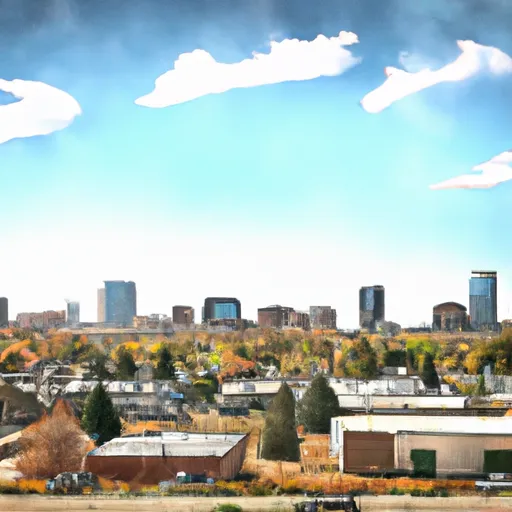-
 Snoflo Premium
Snoflo Premium
Get unlimited access to all our content
With no Ad interruptions! - Start Your Free Trial Login with existing account
Northglenn
Eden Index
Climate
8.7
•
Recreation
4.5
•
Community
3.2
•
Safeguard
5.9/10

Northglenn, Colorado, located in the Denver Metropolitan Area, experiences a semi-arid climate with mild winters and hot summers. The region receives approximately 15 inches of precipitation annually, mainly in the form of snow during the winter months. The hydrology constituents in Northglenn consist of the South Platte River and Big Dry Creek, which run through the city, providing opportunities for fishing and kayaking. Northglenn has several parks and open spaces, including EB Rains Jr. Memorial Park and Webster Lake, offering various outdoor recreational activities such as hiking, biking, and picnicking. The city also maintains a network of trails, allowing residents and visitors to explore the natural beauty of the area.
What is the Eden Index?
The Snoflo Eden Index serves as a comprehensive rating system for regions, evaluating their desirability through a holistic assessment of climate health, outdoor recreation opportunities, and natural disaster risk, acknowledging the profound impact of these factors on livability and well-being.
Climate Health Indicator (CHI): 8.7
Northglenn receives approximately
358mm of rain per year,
with humidity levels near 50%
and air temperatures averaging around
11°C.
Northglenn has a plant hardyness factor of
5, meaning
plants and agriculture in this region thrive during a short period during spring and early summer. Most
plants will die off during the colder winter months.
By considering the ideal temperature range, reliable water supplies, clean air, and stable seasonal rain or snowpacks, the Climate Health Indicator (CHI) underscores the significance of a healthy climate as the foundation for quality living.
A healthy climate is paramount for ensuring a high quality of life and livability in a region, fostering both physical well-being and environmental harmony. This can be characterized by ideal temperatures, reliable access to water supplies, clean air, and consistent seasonal rain or snowpacks.
Weather Forecast
Streamflow Conditions
South Platte
Area Rivers
South Platte
Snowpack Depths
South Platte
Reservoir Storage Capacity
South Platte
Groundwater Levels
Recreational Opportunity Index (ROI): 4.5
The Recreational Opportunity Index (ROI) recognizes the value of outdoor recreational options, such as parks, hiking trails, camping sites, and fishing spots, while acknowledging that climate plays a pivotal role in ensuring the comfort and consistency of these experiences.
Access to outdoor recreational opportunities, encompassing activities such as parks, hiking, camping, and fishing, is crucial for overall well-being, and the climate plays a pivotal role in enabling and enhancing these experiences, ensuring that individuals can engage in nature-based activities comfortably and consistently.
Camping Areas
| Campground | Campsites | Reservations | Toilets | Showers | Elevation |
|---|---|---|---|---|---|
| Cherry Creek State Park | 102 | 5,646 ft | |||
| Chatfield State Park | 193 | 5,494 ft | |||
| Indian Creek | 11 | 7,562 ft | |||
| Flat Rocks | 19 | 8,245 ft | |||
| South Meadows | 64 | 7,897 ft | |||
| Devils Head | 21 | 8,856 ft | |||
| Painted Rocks | 18 | 7,836 ft | |||
| Jackson Creek | 9 | 8,179 ft | |||
| Standley Lake | None | 5,530 ft | |||
| Colorado | 81 | 7,806 ft |
Nearby Ski Areas
Catastrophe Safeguard Index (CSI):
The Catastrophe Safeguard Index (CSI) recognizes that natural disaster risk, encompassing floods, fires, hurricanes, and tornadoes, can drastically affect safety and the overall appeal of an area.
The level of natural disaster risk in a region significantly affects safety and the overall livability, with climate change amplifying these risks by potentially increasing the frequency and intensity of events like floods, fires, hurricanes, and tornadoes, thereby posing substantial challenges to community resilience and well-being.
Community Resilience Indicator (CRI): 3.2
The Community Resilience Indicator (CRI) recognizes that education, healthcare, and socioeconomics are crucial to the well-being of a region. The CRI acknowledges the profound impact of these elements on residents' overall quality of life. By evaluating educational resources, healthcare accessibility, and economic inclusivity, the index captures the essential aspects that contribute to a thriving community, fostering resident satisfaction, equity, and social cohesion.

